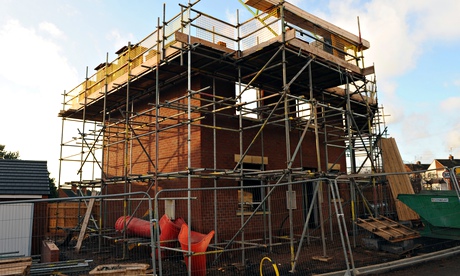Annual GDP growth revised down slightly to 3.0% from 3.1% but still the strongest since 2007, according to latest figures.

Construction helped the economy to grow. Photograph: Joe Giddens/PA Archive/Press Association Ima
The fastest growth in business investment for two years helped
support Britain's overall economic growth in the first quarter, boosting
hopes the recovery is become more sustainable.
GDP grew by 0.8%
in the first three months of the year, the Office for National
Statistics said in its final revision, unchanged from its previous
growth estimate. Annual GDP growth was revised down slightly to 3.0%
from 3.1% but was still the strongest since 2007.
Releasing more
details on what was behind the quarterly growth, the ONS said household
spending remained the driving force while the construction sector picked
up steam. But growth for the dominant services sector was revised lower
from previous estimates.
The first quarter marked an acceleration
from 0.7% growth in the final months of 2013 and the UK economy is now
only 0.6% below its pre-crisis level. Economists say it has most likely
regained its previous strength during the current quarter. Still, the UK
has taken longer than other advanced economies to regain its
pre-recession strength.
"It will have taken the economy more than
six years to surpass the peak level that was seen in the first quarter
of 2008 but it has undoubtedly finally achieved that feat in the second
quarter," said Howard Archer, economist at IHS Global Insight.
He
said news in Friday's figures that business investment was up 5% quarter
on quarter and 10.6% year on year, suggested the recovery was becoming
more entrenched.
"The best news in the GDP data was the marked
upward revision to business investment. This not only indicates that
growth is becoming less centred on consumer spending but could also have
positive implications for future productivity growth," Archer added.
Chris
Williamson, chief economist at data specialists Markit also noted the
improving nature of the recovery. "By sector, growth was encouragingly
broad based. A 1.5% leap in manufacturing output … was accompanied by an
identical jump in construction output … while services sector output
rose 0.8%."
George Osborne welcomed the numbers. "The figures show
that the foundations for a broad based recovery are now in place, with
all four sectors of the economy growing and business investment up by
over 10% over the year," he said in a statement.
There was little
evidence that the improving economy was stemming a trend of households
driving down their savings to spend. The ONS said the household savings
ratio edged up slightly to 4.9% from 4.8% in the final quarter of last
year, but it was down from 6% earlier in 2013.
The ratio estimates
the amount of money households have available to save as a percentage
of their total disposable income. The ONS said real households'
disposable income fell by 0.2% in the first quarter from the previous
three months.
The figures had little impact on views around the
interest rate outlook for the UK, where borrowing costs have been at a
record low of 0.5% for more than five years. Markets are pricing in a
rate rise to 0.75% at the end of the year and economists polled by
Reuters expect policymakers to wait a little longer, hiking in the first
quarter of 2015.
The Bank of England governor, Mark Carney,
reiterated on Friday that when interest rates do rise, they will not
return to pre-crisis levels. "The old normal is not likely to be the new
normal," he said on BBC Radio 4's Today programme.
"Things have
changed. Households have a lot of debt, the government has been
consolidating its financial position, Europe is weak, the pound is
strong, and the financial system has been fundamentally changed."
Separate
data from the ONS on the UK's trading position was less upbeat than the
GDP numbers. The current account deficit – made up of the trade
deficit, plus losses on overseas ventures – came in at 4.4% of GDP, or
£18.5bn, in the first quarter.
That was down from £23.5bn, or 5.7%
of GDP, in the final quarter of 2013 but had not narrowed as much as
City economists had been predicting.

No comments:
Post a Comment